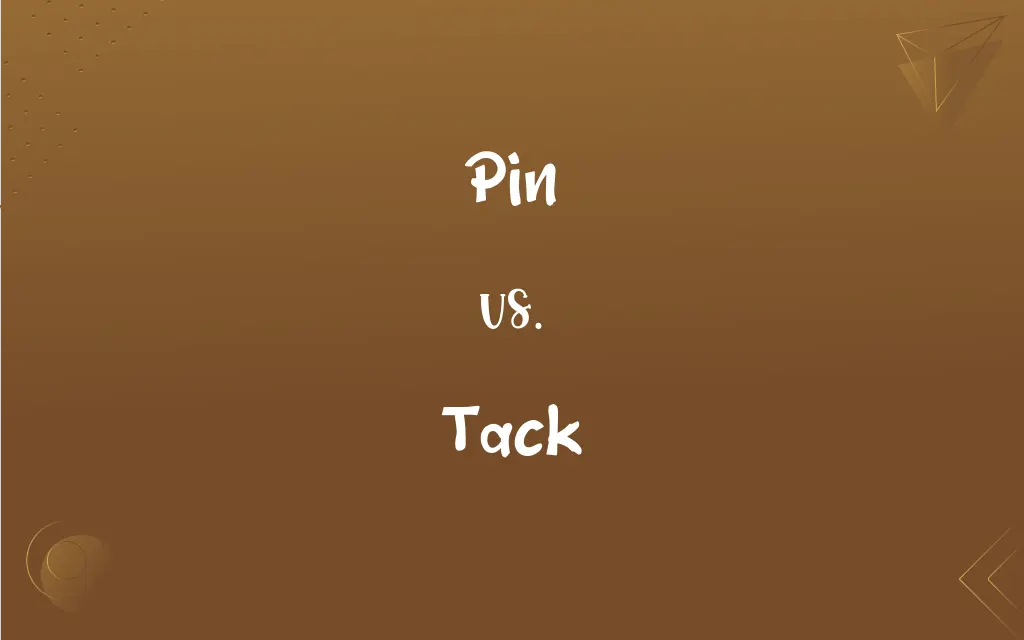Pin vs. Tack: What's the Difference?
Edited by Aimie Carlson || By Harlon Moss || Updated on November 2, 2023
A pin is a thin, sharp piece of metal for holding or attaching materials, while a tack is a short nail with a broad flat head.

Key Differences
Pins and tacks are both small fasteners, but their designs serve different purposes. A pin is usually longer, with a sharp point and often a decorative head. It’s used to hold pieces of fabric together or as a decorative accessory. Tacks, conversely, are short, sharp-pointed nails with a broad, flat head. They are designed to affix items to surfaces like walls or bulletin boards, causing minimal damage.
When considering a pin, think of a delicate object, often used in sewing to temporarily join pieces of cloth. Pins can be very thin and fine, designed to pass through material without causing damage. A tack, however, is sturdier and meant for a more permanent hold. It's driven into a surface to keep items in place.
A pin's use extends beyond practicality; it often serves an aesthetic function. For instance, ornamental pins like brooches are used as jewelry. Tacks don't typically serve a decorative purpose; they're chosen for utility, to pin down papers or to hold layers of material in place during crafts.
In the office, pins might be found on a dressmaker's dummy or in a pincushion, highlighting their association with fabric and design. Tacks are more likely to be seen on a corkboard, holding up notices or photographs. The pin’s design is delicate, suitable for careful, precise work, while a tack is more robust, made for stronger, more decisive applications.
A pin can also refer to something that holds other items in place, like a pin in a machine or a hairpin. A tack, by comparison, is never a machine element and is not associated with the precision of engineering but rather with simple, everyday fixings and mounts.
ADVERTISEMENT
Comparison Chart
Design
Long and thin with a sharp end and usually a head.
Short nail with a sharp point and a broad, flat head.
Usage
For holding fabric, decoration, or precision parts.
For affixing materials to surfaces temporarily.
Associated Material
Fabric, clothing, or delicate materials.
Paper, wall hangings, or light materials.
Head
Often decorative or small.
Always flat and broad.
Purpose in Crafting
Temporary positioning of materials.
Permanent affixing or holding items in place.
ADVERTISEMENT
Pin and Tack Definitions
Pin
A slender, typically U-shaped pin used to hold hair in place.
She kept her bun intact using a hair pin.
Tack
The lower forward corner of a sail's side.
The skipper called to change tack as the wind shifted.
Pin
A pin with a guard that covers the point.
She fastened her broken bag with a safety pin.
Tack
A small, sharp nail with a flat head for hanging documents.
She used a tack to hang the calendar on the wall.
Pin
A split pin that secures two elements in place.
He secured the wheel with a new cotter pin.
Tack
Equipment used on horses, such as saddles and bridles.
She polished the tack before the horse show.
Pin
A slender needle for fastening or decorating fabrics.
She used a pin to secure the pattern to the cloth.
Tack
A loose, temporary stitch in sewing.
The tailor added a tack to hold the pleat in place.
Pin
A decorative pin worn as a piece of jewelry.
He gifted her a diamond pin for her scarf.
Tack
A policy or approach, especially one that represents a change of direction.
The company took a new tack in their marketing strategy.
Pin
A short, straight, stiff piece of wire with a blunt head and a sharp point, used especially for fastening.
Tack
A short, light nail with a sharp point and a flat head.
Tack
A rope for holding down the weather clew of a course.
FAQs
Are all pins made of metal?
Most pins are metal, but some can be plastic, especially for sewing markers.
Can tacks be used in sewing?
Tacks are not typically used in sewing; instead, tack stitches are used for temporary holds.
Is a pin or a tack better for hanging posters?
A tack is better for hanging posters as it can securely affix to a wall.
Can pins be used for jewelry?
Yes, pins like brooches are often used as jewelry.
Are tacks reusable?
Tacks are generally reusable as long as they are not bent or damaged.
Is a thumbtack a type of pin or tack?
A thumbtack is a type of tack with a plastic or metal head for easy insertion.
Are tacks safe to use on all wall surfaces?
Tacks can damage some wall surfaces and should be used with care.
Do pins leave holes in fabric?
Pins can leave tiny holes in fabric, usually not noticeable if used properly.
Do pins come in different sizes?
Yes, pins come in various sizes and lengths for different uses.
What is the primary material pins and tacks are made from?
Both pins and tacks are primarily made from metal.
Can tacks be used on corkboards?
Yes, tacks are ideal for corkboards.
Are tacks reusable after being painted over?
Painted-over tacks may be difficult to reuse due to the paint seal.
Can pins hold weight?
Pins can hold small amounts of weight but are not designed for heavy items.
What is the best way to remove a pin from fabric?
Gently pull the pin out at the same angle it was inserted to avoid fabric damage.
What is a pin used for in machinery?
In machinery, a pin might be used as a pivot or to align parts.
Are safety pins only for fabric?
Safety pins can be used for a variety of temporary fixes, not just fabric.
Is there a difference between a push pin and a tack?
Push pins are a type of tack designed with a plastic head for pushing by hand.
Can you use pins on a bulletin board?
Yes, pins can be used on a bulletin board, but tacks are more common.
Do pins and tacks come in colors?
Yes, both can come in a variety of colors, often with plastic heads or coatings.
Are tacks suitable for outdoor use?
Tacks can be used outdoors but may rust if not specifically designed for exterior use.
About Author
Written by
Harlon MossHarlon is a seasoned quality moderator and accomplished content writer for Difference Wiki. An alumnus of the prestigious University of California, he earned his degree in Computer Science. Leveraging his academic background, Harlon brings a meticulous and informed perspective to his work, ensuring content accuracy and excellence.
Edited by
Aimie CarlsonAimie Carlson, holding a master's degree in English literature, is a fervent English language enthusiast. She lends her writing talents to Difference Wiki, a prominent website that specializes in comparisons, offering readers insightful analyses that both captivate and inform.































































